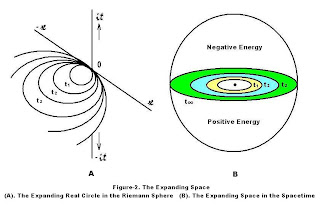So far we have shown that the
process of the spacetime splitting can be described purely from mathematical
analysis. We transformed the complex plane into a Riemann sphere to get a more
pictorial representation of the entire spacetime, including the infinities. The
real space axis (X) on the complex plane is now represented by the real
equatorial circle while the imaginary time axis (it) of the complex
plane by the imaginary longitude circle of the sphere
(Figure-1).
Since the energy in its purest
nature can be described as a wave, mathematically it can be best formulated in
the form of Laurent series f(z) expressed as a sum of its positive frequency
part and the negative frequency part:
f(z) = F+(z) + c0 + F–(z)
When it is mapped on the Riemann
sphere a), the positive frequency F+(z) extends
holomorphically into the southern hemisphere, and the negative frequency F–(z)
extends holomorphically into the northern hemisphere.

The constant c0 is
represented by the real equatorial circle which is the shared boundaries of
those opposing frequencies.
This is how the energy split is
described mathematically into its positive and negative energies. Physically,
we can explain such energy split through the division of the spacetime into two
halves. One half, the southern part of the spacetime, represents the positive
energy zone and the other half, which is the northern part, the negative energy
zone. The interface between those two
opposing zones is the space where all material things, the super-galaxies, a
cluster of galaxies, galaxies, stars, solar system, and the earth are located.
So far we have assumed that the size
of the real equatorial circle on the Riemann sphere or the space in the
spacetime is not changing in time. The
whole spacetime is completely split instantly which makes the universe static.
In term of the Riemann sphere the real circle, which physically represents the
space, immediately gains the infinite equatorial size.

In reality, there is no such a
static universe as supported by the astronomical observations (among other the
Hubble's redshift)b). In line with that, space should be gradually
expanding in time c), depicted by an expanding interface in the
spacetime (Figure-2B). In term of the Riemann sphere, this is represented by an
expanding real circle (Figure-2A).
Now we come to an essential question
as to whether the expanding real circle is starting from the beginning as a
point (singularity) or from certain definite size? As we remember, the Riemann
sphere has a kind of annulus of convergence which excludes a particular area
surrounding the zero point and that of the infinity (Figure-3).
The real circle starts to appear
only after gaining a certain size. This means that space begins to materialize
just after achieving a certain minimum size, below which nature abhors the
existence of such space and all materials within. Also, the annulus of
convergence also indicates that space will disappear entirely after gaining a
certain maximum size for the space to exist.
This means that the real circle (space) d) can take any size as far as it is within the annulus of convergence.
Space appears only after it gains a sufficiently large size and expands
afterward up to a maximum allowable size for the space to exist. After that
space dissolves completely into pure energy. Nature keeps the physical world to
take place outside the vicinity of the singularity and infinity.
Notes:
a)
As the spacetime is the structural
quality of energy, the Riemann sphere becomes the domain of the energy wave
function.
b)
The interpretation of which gave
rise to the Big Bang theory
c)
According to the Big Bang [and the
general relativity] theory, it is the spacetime instead of space which is
expanding.
d)
The real circle on the Riemann
sphere or the physical space within the spacetime framework is not necessarily
flat and may be curved more or less significant.
References:
1.
Penrose, R.: "The Road to Reality," Vintage Books, London, 2005, pp.
159, 172-175.




